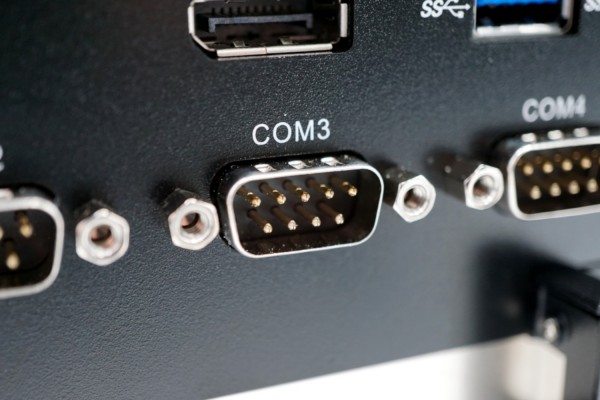Serial and parallel ports
Serial ports, as well as parallel ports serve the transmission of data between computers and peripheral devices. The first is called “serial” because the bits are being transmitted in sequence during this process.
As the name already tells, parallel ports transmit the bits parallel, so multiple bits at a time. The term of the parallel port has become associated with the IEEE 1284 port that is also known as the printer port.
The RS-232 or COM port
Talking about the serial interfaces of a (Mini-) PC, what is meant by this most of the times is the RS-232, better known as the COM port. RS-232 was already developed in 1960 for the telecommunication and IT field. Due to its easy implementation and its reliability, the interface was also used in the entertainment electronics. In 1997 the last update for the RS-232 specifications was released. For a long time PCs and laptops used the RS-232 to connect keypads and mice. By now, the USB port takes care of this task.
As usual for serial ports, the RS-232 transfers the bits in sequence via one single wire. For RS-232 this happens asynchronously and word wise.
The classic RS-232 interface is a 25-pin connector. Since the IT does not need every single one of these signals, the 9-pin connector was established (see image 1). If there is more than one COM port on a housing, the BIOS and the operating system give the physical ports a logical name, COM 1, COM 2 and so on (see image 1).
Data transfer rates of RS-232
As we know it from other cables, for instance HDMI, the data transfer rates depend on – among others – the length of the cable. For the RS-232 standard a maximum capacity, instead of a maximum cable length, is specified. These 2500 pF are reached with a length of 15 meters. There are also cables that show a very low capacity, with which up to 45 meters can be reached.
The RS-232 in times of Industry 4.0
Even today in the era of Industry 4.0 there are so many technical devices in the industrial sector that don’t survive without a serial interface. The RS-232 wins in this field with its functionality, which can be implemented easily and inexpensively, and because the interface is supported by most manufacturers and users.
In contrast to the Universal Serial Bus (USB), RS-232 doesn’t need a special driver for the applied operating system when used as the communication port. This leads to less support effort and to the security against system failures due to possible errors in the programming of the driver. Practice issues with the COM port are very rare. But if there is a problem, it is possible to simply exchange the hardware without touching the sensitive software.
Security overall plays a huge role in the industrial field. COM can score here, too: By using screwable cables, COM protects against dust and moisture in production halls, which also improves the health and increases the lifespan of a Mini-PC.
Differences between RS-232, RS-422 and RS-485
Next to the COM port there are other serial interfaces that have a place in some of our Mini-PCs. On one hand there is the RS-422 standard, also known as EIA-422 and on the other hand there is the RS-485 or EIA-485 standard.
The RS-422 standard stands for a grid-bound differential and serial data transmission. In contrast to RS-232 with unsymmetrical signaling, RS-422 requires a symmetrical signaling.
The RS-485 stands, just like RS-232, for an asynchronous serial, but also just like RS-422 for a symmetrical data transmission.







